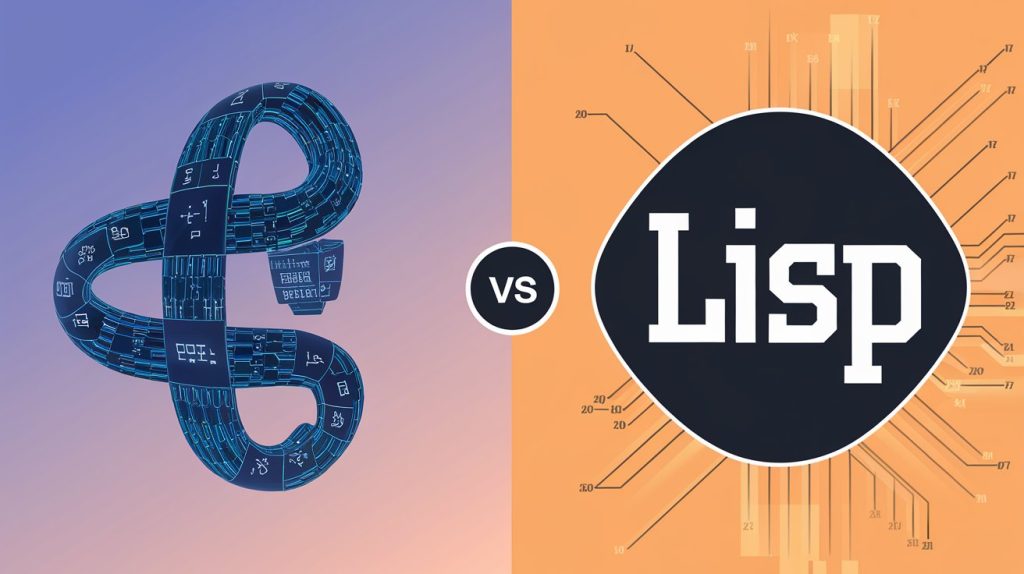The Fortran vs. Lisp debate originated in the late 1950s when the two earth-shaking programming languages emerged serving unique needs. Two programs’ combats!!! Fortran vs Lisp — The Battle of the Giants Fortran vs. Lisp is where efficiency meets flexibility — Fortran (1957) changed the face of numerical computing with its speed and structured programming while Lisp (1958) pioneered symbolic processing and recursion, summarizing artificial intelligence.
Fortran vs Lisp — the legacy continues on through modern programming languages and methodologies, OFL 1.0. Their legacy lives on as they either optimize complex calculations or break ground in AI. In this blog, we will take a look at how Fortran vs Lisp differ, how they differ historically, and what is their last echo in computing.
Fortran VS Lisp

Here we came to know full information related to Fortan and Lisp and comparison also so start your coding journey with Codeburner. in and Techon coders.
Let’s know about FORTRAN in Fortran vs Lisp.

Fortran (short for Formula Translation) is a general-purpose, imperative programming language that is particularly well-suited for numeric and scientific computing. Developed by IBM in the 1950s, Fortran has undergone several revisions over the years, with the latest standard being Fortran 2018. Here is a comprehensive overview of Fortran
Origin and Development
- Year of Introduction:
- Fortran was first introduced in 1957 by IBM (International Business Machines Corporation). It was developed by a team led by John Backus.
- Purpose of Development:
- Fortran was designed for high-level scientific and engineering calculations. It was the first high-level programming language specifically created for numeric and scientific computing.
Key Features:
- Formula Translation:
- Fortran’s name is derived from its primary purpose—translating mathematical formulas into machine code.
- Column-Based Format:
- Early versions of Fortran used a column-based format, where specific columns were reserved for certain purposes (e.g., columns 1-5 for labels, columns 6-72 for code).
- Numeric Processing:
- Fortran was optimized for numeric and scientific calculations, with strong support for array operations and mathematical functions.
- Efficiency:
- Fortran was designed to generate efficient machine code, which was crucial for the computational demands of scientific and engineering applications.
- Static Typing:
- Fortran featured static typing, where variable types needed to be declared explicitly. This contributed to performance optimization.
Versions:
- Fortran I (1957):
- The original version, Fortran I, was the first commercially available version. It lacked some features that would be introduced in later versions.
- Fortran II (1958):
- Fortran II added subroutines, and functions, and improved input/output facilities.
- Fortran III (1958):
- Fortran III was a proposed version that never materialized. Instead, efforts were focused on Fortran IV.
- Fortran IV (1961):
- Fortran IV introduced many features still in use today, including DO loops and logical IF statements.
- Fortran 66:
- An ANSI standard, Fortran 66, was established, incorporating many new features like the END statement, logical expressions, and character data types.
- Fortran 77 (1977):
- Fortran 77 was a major revision, adding features like structured programming constructs and character string manipulation.
- Fortran 90 (1991):
- Fortran 90 introduced modern features such as free-form source code, dynamic memory allocation, and modules.
- Fortran 95 (1997):
- Fortran 95 was a minor revision to Fortran 90, fixing some issues and adding a few features.
- Fortran 2003 :
- This version introduced features like object-oriented programming, improved support for interoperability with C, and more.
- Fortran 2008:
- Fortran 2008 further enhanced the language with features like arrays for parallel programming, additional intrinsic procedures, and improvements in interoperability.
- Fortran 2018:
- The latest standard as of my knowledge cut off in January 2022, Fortran 2018 includes various enhancements, such as additional features for parallel programming, improved interoperability with C, and enhanced support for modern hardware.
Impact:
- Scientific Computing:
- Fortran quickly became the language of choice for scientific and engineering applications due to its efficiency in numeric computations.
- Legacy Code:
- Many legacy scientific codes are still written in Fortran, and efforts have been made to modernize and optimize them without a complete rewrite.
- Influence on Programming Languages:
- Fortran’s influence can be seen in subsequent programming languages designed for scientific computing, such as MATLAB and Julia.
- Parallel Computing:
- Modern versions of Fortran have features that facilitate parallel computing, making it relevant in contemporary high-performance computing environments.
Fortran has had a significant impact on the field of scientific computing, and its legacy continues to influence the development of programming languages for numerical and scientific applications.
Let’s learn about LISP in Fortran vs Lisp.

Lisp (short for LISt Processing) is a family of programming languages known for their unique approach to programming through the manipulation of symbolic expressions, particularly lists. Lisp was first developed by John McCarthy in the late 1950s, and since then, it has undergone various dialects and implementations. Common Lisp and Scheme are two of the most prominent Lisp dialects.
Key Features:
Symbolic Expression (S-expression):
Lisp programs are built using symbolic expressions, often represented as nested lists. The basic building blocks are atoms and lists.
Example: (define square (x) (* x x))
Dynamic Typing:
Lisp is dynamically typed, meaning that variable types are determined at runtime.
1. Garbage Collection:
Automatic memory management is a key feature in Lisp. Garbage collection relieves programmers from manual memory allocation and deallocation tasks.
2. Code as Data:
In Lisp, code and data have the same representation. This allows powerful metaprogramming and the creation of domain-specific languages.
3. Interactivity:
Lisp environments often provide a REPL (Read-Eval-Print Loop), allowing developers to interactively experiment with code.
Functional Programming:
Lisp supports functional programming paradigms, including first-class functions, higher-order functions, and lexical closures.
4. Macros:
Lisp macros allow the creation of new language constructs, extending the language itself. This feature is powerful for code generation and metaprogramming.
Dialects:
5. Common Lisp:
Common Lisp (CL) is a standardized and feature-rich Lisp dialect. It includes a large standard library and is designed for both systems programming and application development.
Scheme:
Scheme is a minimalist Lisp dialect, designed with a focus on simplicity and a small core set of features. It is often used in educational settings.
Clojure:
Clojure is a modern Lisp dialect designed for concurrent and functional programming on the Java Virtual Machine (JVM). It has a strong emphasis on immutability and embraces modern programming practices.
(defun square (x)(* x x))
(format t "The square of 5 is ~d" (square 5))
Implementation:
Lisp has various implementations, including:
GNU Emacs Lisp: Embedded in the Emacs text editor.
SBCL (Steel Bank Common Lisp): An open-source implementation.
Closure CL: An implementation supporting both 32-bit and 64-bit systems.
Lisp has had a significant impact on the field of artificial intelligence and remains influential in certain niches, such as symbolic computing and metaprogramming. While not as widely used in mainstream development, Lisp continues to have a devoted following, and its principles have influenced the design of many modern programming languages.
Key differences between Fortran vs Lisp
Fortran vs. Lisp: A Battle Between Two Fundamental Programming Paradigms From the Late 1950s Fortran versus Lisp is a core dichotomy—the former (1957) was intended for high-speed numerical and scientific computing while the latter (1958) introduced symbolic processing and artificial intelligence programming. The comparisons of Fortran vs Lisp reflect their different emphasis on structured, procedural mathematical expressions and loops versus recursive dynamic typing, and list-based symbolic computation – driven by the efficiency or exploratory character of each language.
Syntax is one of the most apparent differences in Fortran vs. Lisp. Fortran uses algebraic notation, crippled data types with purposefully fixed types optimized for calculation, while Lisp depends on lists, prefix notation and dynamic symbolic processing. Another rubber meets the road topic is the efficiency part of the Fortran vs Lisp debate—Fortran is extremely efficient due to its optimizing high-performance computing generation techniques, and makes an easy choice for engineering and scientific research, while Lisp, with high flexibility, is far less efficient most of the time due to the handling of dynamic data and garbage collection.
Fortran vs Lisp had a colossal influence on modern programming, nevertheless their differences. Fortran had a huge legacy on languages like C, MATLAB and Julia, and Lisp cleared the way for functional languages like Scheme, Clojure and even parts of Python. Fortran vs. Lisp: Fifty Yrs. Many tradeoffs in efficiency and flexibility have survived, so they remarkably shape the way we program today.
Conclusion Fortran vs Lisp – The Original Programming Battle
The Fortran vs Lisp (1957-1958) war was one of several formative experiences in software history. Specialized for number-crunching and scientific applications, Fortran was the bedrock of high-performance computing, Lisp with its groundbreaking ability to manipulate symbols would serve as the basis for artificial intelligence and functional programming.
The two languages also broke new ground concepts that are still being used today. Lisp was dynamically typed (and compiled), leading many modern languages to use it as a source of inspiration, such as Python or JavaScript.
